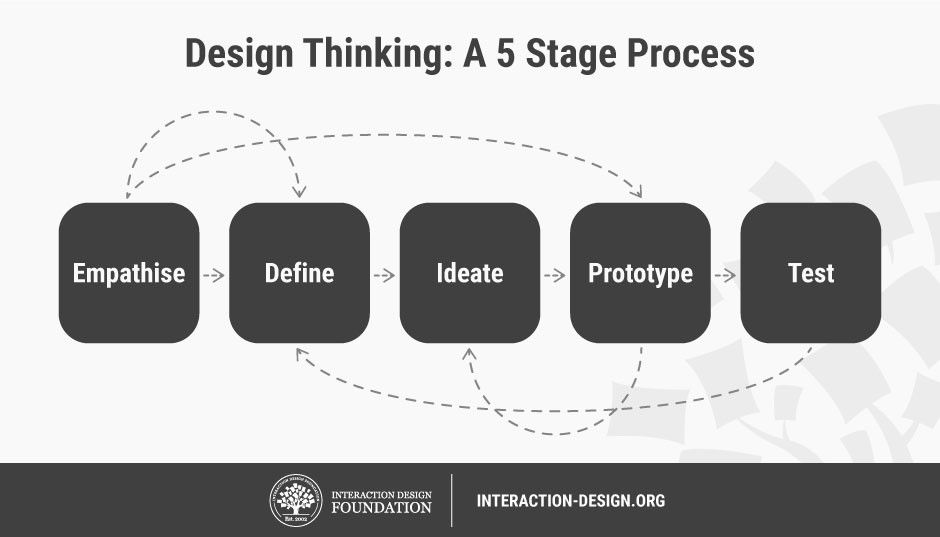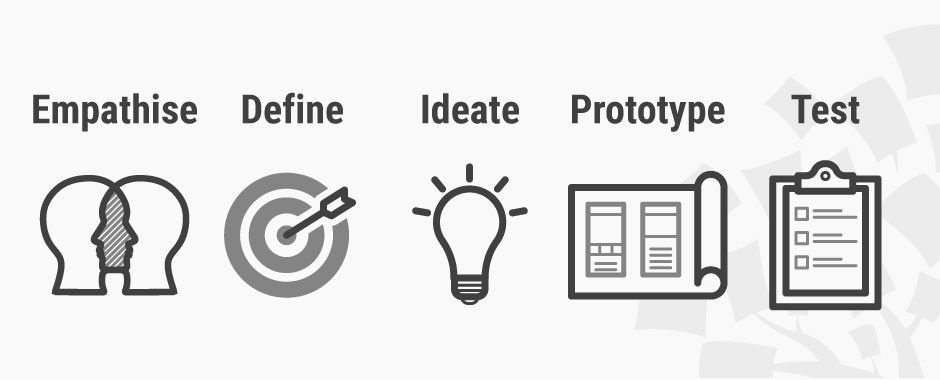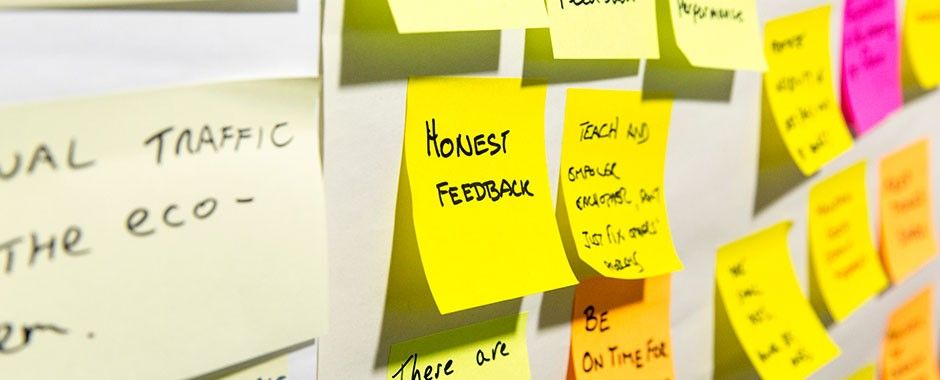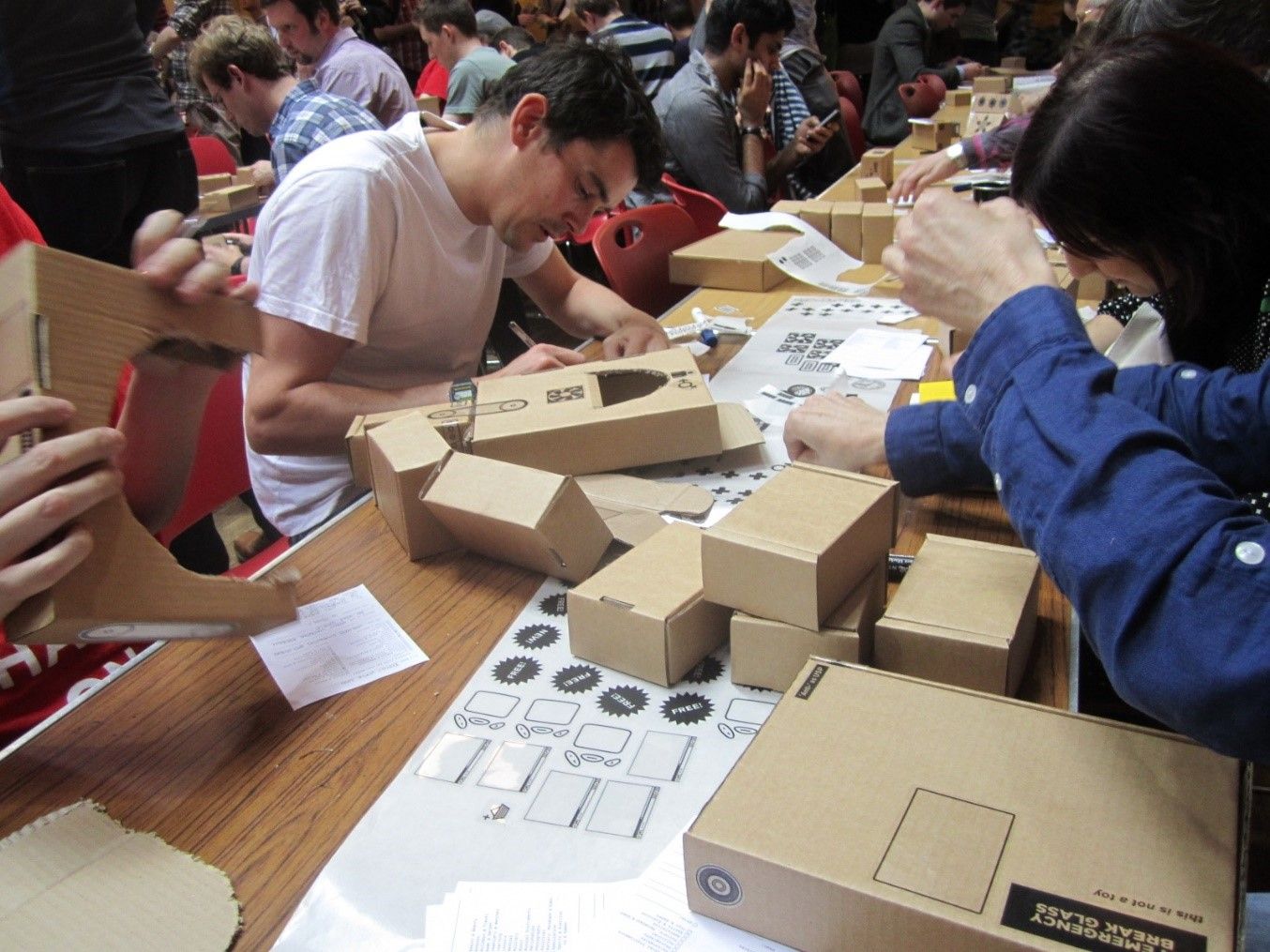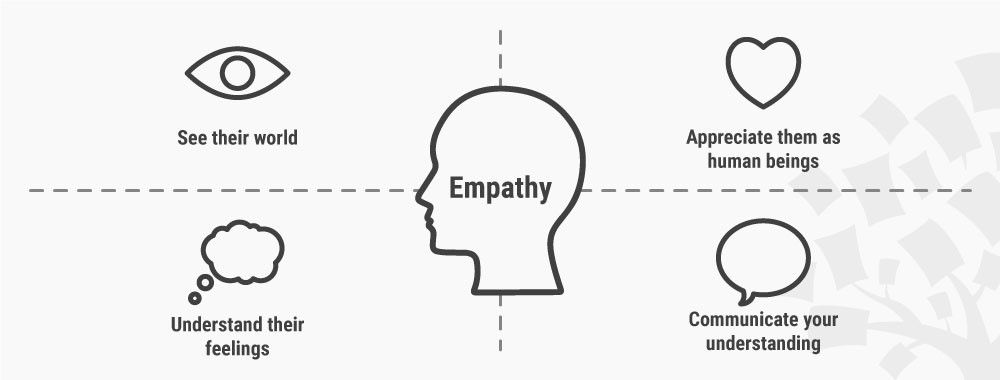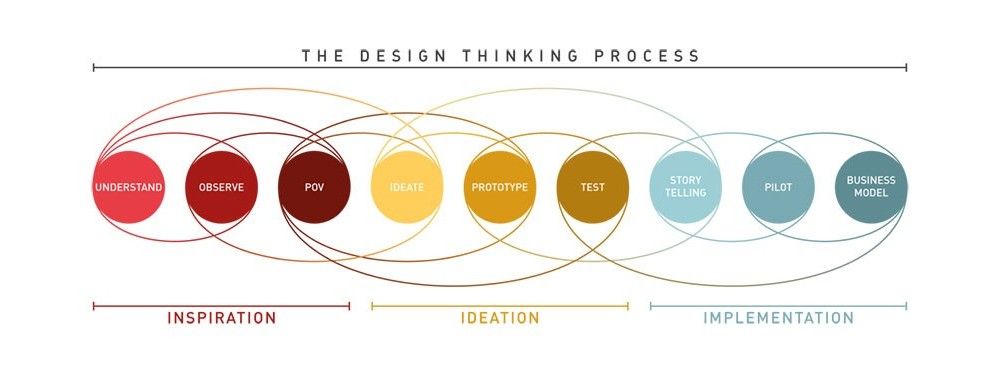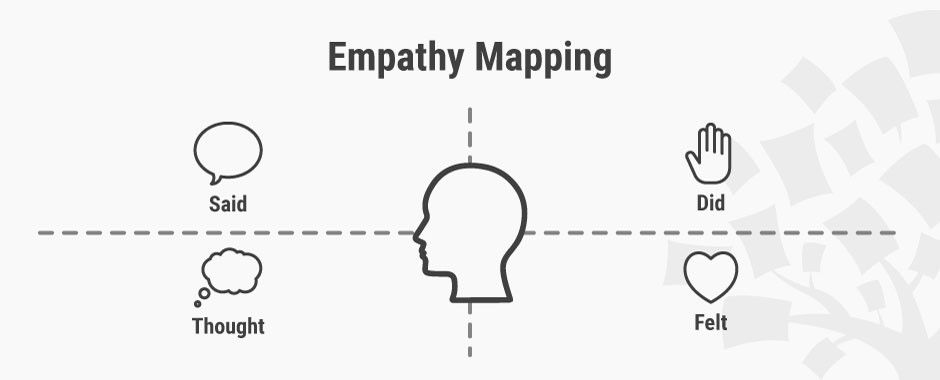Empathy is an important element in Design Thinking and Human-Centred Design. What is empathy exactly? Why is empathy so important to designing solutions that actually work for people? Here, we’ll not only look at what empathy means, but will also look at how it helps design thinkers create solutions that work and, conversely, how a lack of empathy can result in product failure. We’ll also come to understand the empowering notion that everyone can master empathy and design truly human-centred solutions.
What Is Empathy Exactly?
In a general sense, empathy is our ability to see the world through other people's eyes, to see what they see, feel what they feel, and experience things as they do. Of course, none of us can fully experience things the way someone else does, but we can attempt to get as close as possible, and we do this by putting aside our own preconceived ideas and choosing to understand the ideas, thoughts, and needs of others instead.
In Design Thinking, empathy is, as explained in IDEO’s Human-Centred Design Toolkit, a “deep understanding of the problems and realities of the people you are designing for”. It involves learning about the difficulties people face, as well as uncovering their latent needs and desires in order to explain their behaviours. To do so, we need to have an understanding of the people’s environment, as well as their roles in and interactions with their environment.
Empathy helps us gain a deeper appreciation and understanding of people's emotional and physical needs, and the way they see, understand, and interact with the world around them. It will also help us to understand how all of this has an impact on their lives generally, specifically within the contexts being investigated. Unlike traditional marketing research, empathic research is not concerned with facts about people (such as their weight or the amount of food they eat), but more about their motivations and thoughts (for instance, why they prefer to sit at home watching TV as opposed to going out for a jog). It’s inherently subjective, since there is a fair amount of interpretation involved in finding out what people mean rather than what they say.
Empathise
 Author/Copyright holder: Teo Yu Siang and Interaction Design Foundation. Copyright terms and licence: CC BY-NC-SA 3.0
Author/Copyright holder: Teo Yu Siang and Interaction Design Foundation. Copyright terms and licence: CC BY-NC-SA 3.0
“Empathise” is the first stage of the Design Thinking process. The following stages can be summarised as: Define, Ideate, Prototype and Test. In the empathise stage, your goal, as a designer, is to gain an empathic understanding of the people you’re designing for and the problem you are trying to solve. This process involves observing, engaging, and empathising with the people you are designing for in order to understand their experiences and motivations, as well as immersing yourself in their physical environment in order to have a deeper personal understanding of the issues, needs and challenges involved.
Empathy is crucial to a human-centred design process such as Design Thinking, and empathy helps design thinkers to set aside his or her own assumptions about the world in order to gain insight into their users and their needs. Depending on your time constraints, you will want to gather a substantial amount of information at this stage of the Design Thinking process. In the Empathise stage of a Design Thinking process, you will develop the empathy, understandings, experiences, insights and observations on which you will use to build the rest of your design project. We cannot stress enough how important it is for designers such as us to develop the best possible understanding of our users, their needs, and the problems that underlie the development of the particular product or service we’re aiming to design. If you have time and money, you should also consider consulting experts in order to find out more about the people you design for, but you’ll be surprised at how much insight you and your team can easily gain via practical Empathise methods.
Empathise methods
The following are our favourite Empathise methods:
- Assume a beginner’s mindset
- Ask What-How-Why
- Ask the 5 whys
- Conduct interviews with empathy
- Build empathy with analogies
- Use photo and video user-based studies
- Use personal photo and video journals
- Engage with extreme users
- Story share-and-capture
- Bodystorm
- Create journey maps
However, you will need to understand the following nuances and potentials of empathy before you start using the above (amazing) methods.
Empathy vs. Sympathy
Sympathy, a word often confused with empathy, is more about one's ability to have or show concern for the wellbeing of another, whereas to sympathize does not necessarily require one to experience in a deep way what others experience. Additionally, sympathy often involves a sense of detachment and superiority; when we sympathise, we tend to project feelings of pity and sorrow for another person.
This feeling of pity and sorrow may not only rub people up the wrong way, but it is also useless in a Design Thinking process. In Design Thinking, we are concerned with understanding the people for whom we are designing solutions—for doing something that can help them. When we visit our users in their natural environments in order to learn about how they behave, or when we conduct interviews with them, we are not seeking for opportunities to react to the people; rather, we want to absorb what they are going through, and feel what they are feeling.
Why Empathy?
Moving Away from the Industrial Revolution
Since the invention of factories in the industrial revolution opened the gates to mass-produced goods, mass consumerism has been an ever-growing part of how the world operates. However, the one-size-fits-all approach to consumption and solving problems has begun to show signs of inadequacy.
The truth is, using the power of “averages” is a terrible way to design solutions for people. In the 1940s, the US Air Force learnt this the hard way. During this era, aviation accidents happened very frequently (as many as 17 crashes a day). Initially, the air force presumed that the reason for so many accidents was the air force’s switch to using more complicated and faster planes. After some research, however, the air force discovered the real reason behind the accidents; they had designed the planes’ cockpits and helmets to conform to the dimensions of the “average” soldier’s body. In a study of over 4,000 air force pilots, it was found that none of the air force pilots fell within the dimensions of the supposed “average” man. It was no wonder pilots had problems with using the planes! In the end, the air force created adjustable equipment to fit most soldiers’ bodies, thereby solving the problem.
Besides the problems with designing solutions based on averages, our mass consumerism has a further issue: the high rate at which we are generating waste. In the past decade, our consumption has turned global warming from a growing issue to an imminent crisis that threatens to change the way we live (and even survive). Design Thinking, and in particular empathy, is about creating solutions that are sustainable and focused on all pertinent areas that can affect us in the long term.
 Author/Copyright holder: Petter Rudwall. Copyright terms and licence: CC0
Author/Copyright holder: Petter Rudwall. Copyright terms and licence: CC0
Mass consumption, driven by the industrial revolution and the invention of factories, is putting a huge environmental cost on our planet.
What They Say and What They Don't Say
People do not always convey all the details. They may withhold information out of fear, distrust or some other inhibiting factor, be it internal or based on those with whom they are engaging. Additionally, they may express themselves in ways not extremely articulate, thus requiring the listener to make sense of what is not being said or what is being hinted at, beneath the external expressions and words. As designers, we need to develop intuition, imagination, emotional sensitivity, and creativity in or to dig deeper without prying too personally, in order to extract the right kinds of insight so as to make a more meaningful difference.
In other words, we need empathy so as to understand people thoroughly. Empathy is the difference between taking what your users say at face value and observing what IDEO Executive Design Director Jane Fulton Suri describes as “thoughtless acts” — small acts people exhibit that reveal how their behaviours are shaped by their environments. When people perform thoughtless acts such as hanging their sunglasses on their shirts, or wrapping coloured stickers around their keys to differentiate them, it’s a sign of how an imperfectly tailored environment forces an almost unconscious reaction on their part. However, we can find opportunities for new insights and new solutions to help people within unconscious acts.
Empathy is Crucial to Business Success
Many leaders within the innovation, learn, and entrepreneurship spaces in which Design Thinking is prevalent have repeatedly pointed to three key parameters that define a successful product or service. They are: desirability, feasibility, and viability.
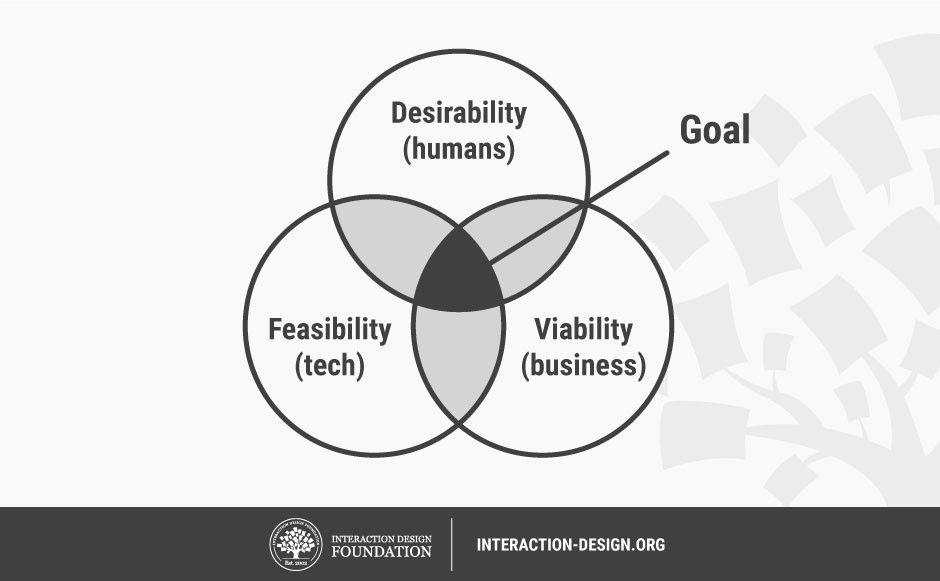 Author/Copyright holder: Teo Yu Siang and Interaction Design Foundation. Copyright terms and licence: CC BY-NC-SA 3.0
Author/Copyright holder: Teo Yu Siang and Interaction Design Foundation. Copyright terms and licence: CC BY-NC-SA 3.0
It is not enough that the technology or means exist (i.e., feasibility is present) and that profits or business benefits may be derived (i.e., it is viable). It is essential for users to actually have a sense of desirability towards a solution. We can only fully understand and design a desirable product or service when people's needs, experiences, wants, and preferences are properly understood.
From a purely business profit-driven perspective, empathy is an essential component of any sound business solution. If we develop solutions in isolation, without essential insights about our users, we may create solutions that completely miss the mark and thus be ignored by the market. For example, many MP3 players have come and gone without much creating much of an impact, whereas the iPod was very successful at not only providing a technological solution but also providing a completely desirable and profitable experience, which resulted in Apple’s taking a market lead.
As Frank Chimero, illustrator and author of The Shape of Design, says:
“People ignore design that ignores people”.
– Frank Chimero
Designing Without Empathy: Google Glass
Google launched its first wearable product, the Google Glass, with much fanfare in 2013. The head-mounted wearable computer, while being technologically impressive, failed to perform well, and a lot of that comes down to a lack of empathy towards the users.
Although the Glass allows users to take photos, send messages and view other information such as weather and transport directions, it does not actually fulfil the real needs of users. In other words, although the Glass performs many things, these are not things you need or want to get done.
Also, the Glass is generally a voice-activated device, and in our current social environment, saying commands out loud in the streets such as, “Okay Glass, send a message,” just isn’t a socially acceptable thing to do. Google’s lack of empathic understanding in the user’s social environment is evident here; if the user has to perform socially awkward or unacceptable acts to be able to use your product, you can be sure that few people would be willing to use your product.
Lastly, the Glass featured a nondescript camera which resulted in privacy concerns for those people around the Glass user, since there was no way of knowing whether or not they were being filmed. All of these problems can be traced back to Google’s lack of empathy when they designed the Glass, and this point is summed up nicely by the MIT Technology Review in one sentence:
“No one could understand why you’d want to have that thing on your face, in the way of normal social interaction.”
– MIT Technology Review
 Author/Copyright holder: Antonio Zugaldia. Copyright terms and licence: CC BY 2.0
Author/Copyright holder: Antonio Zugaldia. Copyright terms and licence: CC BY 2.0
The commercial failure of Google Glass can be traced to Google’s lack of empathy towards users: voice-activated actions are socially awkward, the camera creates a privacy concern for people around the Glass user, and the device doesn’t seem to solve any specific user needs.
Success with Empathy: The Embrace Warmer
With empathy, we can gain insights that could not be gathered by any other methods short of highly accurate calculated guesses. A team of postgraduate students at Stanford were tasked with developing a new type of incubator for developing countries. Their direct contact with mothers in remote village settings who were unable to reach hospitals, helped them to reframe their challenge to a warming device rather than a new kind of incubator.
 Author/Copyright holder: Embrace Innovations. Copyright terms and licence: Fair Use.
Author/Copyright holder: Embrace Innovations. Copyright terms and licence: Fair Use.
The end result was The Embrace Warmer, which has the potential to save thousands of lives. The Embrace Warmer is capable of going where no incubator could go before, due to its portability and dramatically reduced production costs. The Embrace Warmer is an ultra-portable incubator which can be wrapped around an infant and be used while the infant is held in the mother’s arm. Instead of needing to deposit their babies into far-flung hospitals, mothers in remote villages can use a portable warmer that serves the same need instead.
Had the team only thought of designing incubators, they may have developed a semi-portable lower cost incubator, which would still not have made it into remote villages. However, with the help of empathy—i.e., understanding the problems mothers in remote villages face—the design team designed a human-centred solution that proved to be optimal for mothers in developing countries. The objective of empathic research is uncovering, at times, intangible needs and feelings, that indicate what should ideally change in the product, system, or environment we're focusing on. Empathic research reveals the deeper needs and root causes, which, if addressed correctly, may profoundly change the project we're investigating. Instead of constantly designing new patches to cover or ease the symptoms only momentarily, we have the power to create a paradigm shift and provide a wide range of benefits packaged into a single solution. We can create new markets and move whole communities closer to higher order needs and goals. We can change the world when we operate at the appropriate levels.
Anyone Can Master Empathy
The empathy aspects of Design Thinking are named differently depending on whose version you might be following, but the core is essentially the same—i.e., being deeply human-centred. Different schools and Design Thinking companies have called empathic research "the Empathise stage" (which is the term we use), "the understand phase", and "the hear phase", and "looking", as well as a number of other terms.
If you are worried that you are unable to master the ability to be empathic towards the people you are designing for fully, there is good news. Neuroscientists have recently discovered that empathy is hard-wired into the way humans are made and is an integral part of our physiology. They discovered that while humans observe others performing certain actions, or experience certain states, the observer's brain activity resembles someone actually engaged in the activity being observed. In other words, empathy is an innate quality that we can all make use of in order to design for the people around us.
We have all experienced the flurry of emotions or the rush of adrenalin experienced though merely observing someone else engaged in certain activities. We are empathic beings by our very nature, though, to a large extent, our social contexts and learning may work to remove this built-in empathy, or, at the very least, tame it. When you engage with the people you design for, keeping an open mind and being conscientious about developing empathy is key to a successful Design Thinking process and end product.
The Take Away
Empathy is important for us as designers and particularly for design thinkers because it allows us to truly understand and uncover the latent needs and emotions of the people we are designing for. As such, we can design solutions that meet the three parameters of a successful product or service: desirability, feasibility and viability. In Design Thinking, we call this "the Empathise stage". Designing with empathy is what separates a human-centred product like The Embrace Warmer from another, such as Google’s Glass. The good news is that everybody can master empathy and become a great design thinker: we are all innately empathic.
References & Where to Learn More
The Star, When U.S. air force discovered the flaw of averages, 2016: https://www.thestar.com/news/insight/2016/01/16/when-us-air-force-discovered-the-flaw-of-averages.html
Jane Fulton Suri, Thoughtless Acts?, 2005: https://www.ideo.com/by-ideo/thoughtless-acts
The Embrace Warmer: http://embraceglobal.org/about-us/
MIT Technology Review, Google Glass Is Dead; Long Live Smart Glasses, 2014: https://www.technologyreview.com/s/532691/google-glass-is-dead-long-live-smart-glasses/
IDEO: Human-Centered Design Toolkit, 2009: https://www.ideo.com/work/human-centered-design-toolkit/
Psychology Today, The Neuroscience of Empathy, 2013: https://www.psychologytoday.com/blog/the-athletes-way/201310/the-neuroscience-empathy
Hero Image: Author/Copyright holder: Rémi Walle. Copyright terms and licence: CC0



